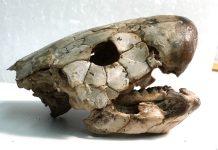
An international team of scientists from China, the U.S., and Europe has brought to light an extraordinary marine reptile, Dinocephalosaurus orientalis, known for its strikingly long neck, reminiscent of dragons from Chinese mythology.
The culmination of a decade-long study, the research findings have been published in the Earth and Environmental Science: Transactions of the Royal Society of Edinburgh, coinciding with the Chinese Year of the Dragon.
The journey to fully understand Dinocephalosaurus orientalis began in 2003 with the discovery of a skull and the first three cervical vertebrae in the Guanling Formation of Guizhou Province, China.
Subsequent finds across southwestern China have enabled researchers to piece together virtually the entire skeleton of this enigmatic creature, offering the first complete glimpse of its physical form and lifestyle.
Dinocephalosaurus, with its 32 cervical vertebrae, boasted an exceptionally long neck, drawing comparisons to the Tanystropheus hydroides, another long-necked marine reptile from the Middle Triassic period found in Europe and China.
However, Dinocephalosaurus set itself apart with numerous unique features, including a greater number of vertebrae in both its neck and trunk, and a viviparous mode of reproduction, indicating it gave birth to live young rather than laying eggs.
Adapted superbly to life in the ocean, its fin-like limbs and the preserved remains of fish found in its stomach area highlight its predatory nature.
Dr. Nick Fraser, from the National Museum of Scotland and one of the study’s authors, expressed excitement over the discovery, noting the creature’s resemblance to mythical Chinese dragons and its potential to captivate imaginations worldwide.
Dr. Stephan Spiekman, a specialist in long-necked marine reptiles at the State Museum of Natural History Stuttgart, pointed out the distinct differences between Dinocephalosaurus and the later plesiosaurs, debunking any close evolutionary ties.
The collaborative effort led by Dr. Li Chun, a curator at the Institute of Vertebrate Paleontology and Paleoanthropology in Beijing, underscores the significant contributions of international partnerships in expanding our understanding of prehistoric life.
With these new specimens, researchers have not only broadened our knowledge of Dinocephalosaurus but also opened new avenues for exploring the evolution and ecological roles of long-necked marine reptiles.
As scientists continue to investigate these ancient seas, further insights are expected into the function of the long neck in marine reptiles and the diverse ecosystems they inhabited.
The story of Dinocephalosaurus orientalis is a testament to the power of paleontology to unearth the mysteries of our planet’s distant past, revealing creatures as fascinating as they are formidable.
The research findings can be found in Earth and Environmental Science: Transactions of the Royal Society of Edinburgh.
Copyright © 2024 Knowridge Science Report. All rights reserved.



